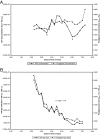Kinetic analysis of growth rate, ATP, and pigmentation suggests an energy-spilling function for the pigment prodigiosin of Serratia marcescens
- PMID: 18805986
- PMCID: PMC2576671
- DOI: 10.1128/JB.00909-08
Kinetic analysis of growth rate, ATP, and pigmentation suggests an energy-spilling function for the pigment prodigiosin of Serratia marcescens
Abstract
Serratia marcescens is a gram-negative environmental bacterium and opportunistic pathogen. S. marcescens expresses prodigiosin, a bright red and cell-associated pigment which has no known biological function for producing cells. We present here a kinetic model relating cell, ATP, and prodigiosin concentration changes for S. marcescens during cultivation in batch culture. Cells were grown in a variety of complex broth media at temperatures which either promoted or essentially prevented pigmentation. High growth rates were accompanied by large decreases in cellular prodigiosin concentration; low growth rates were associated with rapid pigmentation. Prodigiosin was induced most strongly during limited growth as the population transitioned to stationary phase, suggesting a negative effect of this pigment on biomass production. Mathematically, the combined rate of formation of biomass and bioenergy (as ATP) was shown to be equivalent to the rate of prodigiosin production. Studies with cyanide inhibition of both oxidative phosphorylation and pigment production indicated that rates of biomass and net ATP synthesis were actually higher in the presence of cyanide, further suggesting a negative regulatory role for prodigiosin in cell and energy production under aerobic growth conditions. Considered in the context of the literature, these results suggest that prodigiosin reduces ATP production by a process termed energy spilling. This process may protect the cell by limiting production of reactive oxygen compounds. Other possible functions for prodigiosin as a mediator of cell death at population stationary phase are discussed.
Figures






Similar articles
-
Production of prodigiosin pigment by Serratia marcescens is negatively associated with cellular ATP levels during high-rate, low-cell-density growth.Can J Microbiol. 2020 Mar;66(3):243-255. doi: 10.1139/cjm-2019-0548. Epub 2020 Jan 10. Can J Microbiol. 2020. PMID: 31922894 Free PMC article.
-
Prodigiosin pigment of Serratia marcescens is associated with increased biomass production.Arch Microbiol. 2018 Sep;200(7):989-999. doi: 10.1007/s00203-018-1508-0. Epub 2018 Apr 3. Arch Microbiol. 2018. PMID: 29616306 Free PMC article.
-
Effect of various growth conditions on pigmentation of Serratia marcescens.Microbios. 1994;79(320):155-61. Microbios. 1994. PMID: 7968668
-
High-level production of microbial prodigiosin: A review.J Basic Microbiol. 2021 Jun;61(6):506-523. doi: 10.1002/jobm.202100101. Epub 2021 May 5. J Basic Microbiol. 2021. PMID: 33955034 Review.
-
Production and Potential Applications of Bioconversion of Chitin and Protein-Containing Fishery Byproducts into Prodigiosin: A Review.Molecules. 2020 Jun 13;25(12):2744. doi: 10.3390/molecules25122744. Molecules. 2020. PMID: 32545769 Free PMC article. Review.
Cited by
-
Nonphotosynthetic pigments as potential biosignatures.Astrobiology. 2015 May;15(5):341-61. doi: 10.1089/ast.2014.1178. Epub 2015 May 5. Astrobiology. 2015. PMID: 25941875 Free PMC article.
-
Production of prodigiosin pigment by Serratia marcescens is negatively associated with cellular ATP levels during high-rate, low-cell-density growth.Can J Microbiol. 2020 Mar;66(3):243-255. doi: 10.1139/cjm-2019-0548. Epub 2020 Jan 10. Can J Microbiol. 2020. PMID: 31922894 Free PMC article.
-
Prodigiosin - A Multifaceted Escherichia coli Antimicrobial Agent.PLoS One. 2016 Sep 9;11(9):e0162412. doi: 10.1371/journal.pone.0162412. eCollection 2016. PLoS One. 2016. PMID: 27612193 Free PMC article.
-
Exceptional production of both prodigiosin and cycloprodigiosin as major metabolic constituents by a novel marine bacterium, Zooshikella rubidus S1-1.Appl Environ Microbiol. 2011 Jul;77(14):4967-73. doi: 10.1128/AEM.01986-10. Epub 2011 Jun 3. Appl Environ Microbiol. 2011. PMID: 21642414 Free PMC article.
-
SdhE is a conserved protein required for flavinylation of succinate dehydrogenase in bacteria.J Biol Chem. 2012 May 25;287(22):18418-28. doi: 10.1074/jbc.M111.293803. Epub 2012 Apr 3. J Biol Chem. 2012. PMID: 22474332 Free PMC article.
References
-
- Atlas, R. M. 1993. Handbook of microbiological media, p.673. CRC Press, Boca Raton, FL.
-
- Bennett, J. W., and R. Bentley. 2000. Seeing red: the story of prodigiosin. Adv. Appl. Microbiol. 471-32. - PubMed
-
- Bu'Lock, J. D. 1961. Intermediary metabolism and antibiotic synthesis. Adv. Appl. Microbiol. 3293-342. - PubMed
-
- Coulthurst, S. J., C. L. Kurz, and G. P. Salmond. 2004. luxS mutants of Serratia defective in autoinducer-2 dependent quorum sensing show strain-dependent impacts on virulence and production of carbapenem and prodigiosin. Microbiology 1501901-1910. - PubMed
Publication types
MeSH terms
Substances
LinkOut - more resources
Full Text Sources
Other Literature Sources

